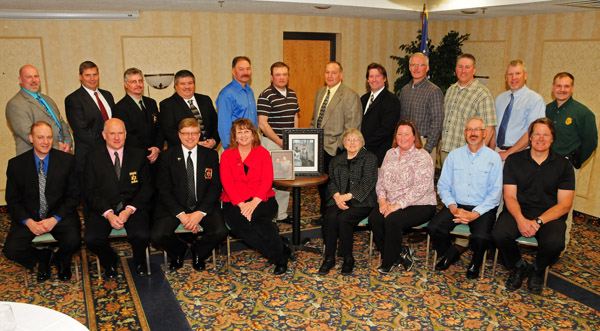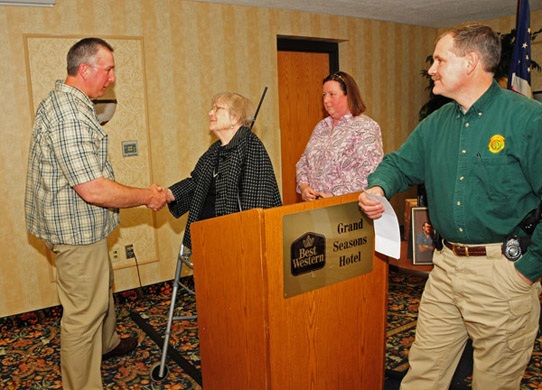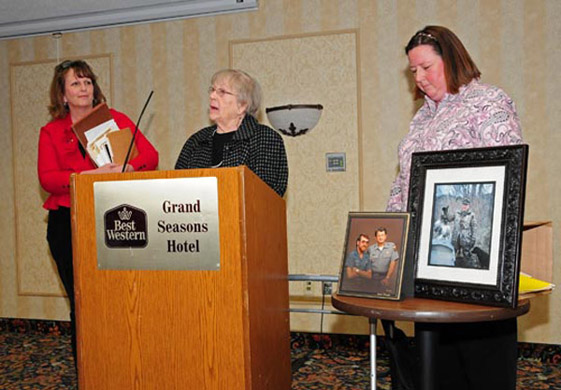LAST UPDATED: May 1st, 2015
WAUPACA, Wis. — When Conservation Warden Ted Dremel studied the carnage where three men used snowmobiles to massacre six deer on a cold January night in 2009, he thought there was little chance of catching the criminals. Except for boot prints, widespread gore and bloody brutality frozen in snow on a dairy farm six miles south of this central-Wisconsin town, Dremel found few clues. It looked like the snowmobilers had chased and corralled the deer in the field like cowboys herding longhorns. Five deer lay dead in the field near a popular snowmobile trail, their legs and ribs broken. They hadn’t been able to run fast enough in the deep snow to escape, and were run down one by one. One deer was gruesomely ripped open and eviscerated by a snowmobile’s spinning track after the driver rode atop it and revved the engine.

It took a team effort to track down and convict three men for using their snowmobiles to kill six deer in central Wisconsin in January 2009.
Later that day, the farmer who owned the land found a sixth deer tied by its neck to a nearby tree. When Dremel later questioned one of the suspects, the man said they’d dragged it there with a tow rope and tied it to the tree because “warm deer skin easier than cold ones.” But they never returned to claim its venison. Although Dremel feared he might never catch the criminals, he knew an atrocity when he saw one. So did the public when Dremel shared the details with TV, radio and newspapers across Wisconsin. The news soon flashed nationwide and internationally. Dremel, the Department of Natural Resources and the Waupaca County Sheriff’s Department suddenly had more tips, leads, theories, accusations and false confessions than one office could handle, let alone budget for. Soon, the U.S. Fish and Wildlife Service volunteered its crime lab to analyze DNA evidence. Snowmobile clubs, outraged that their winter sport was tainted by the crime, rallied to offer rewards and calm private landowners who threatened to close trails crossing their properties.
Wisconsin Conservation Warden Ted Dremel.
Within 48 hours, the deluge of tips and focused efforts of law-enforcement agencies led investigators to three Weyauwega men: Rory Kuenzi, Robbie Kuenzi and Nicholas Hermes. They were subsequently convicted. Robbie Kuenzi, 27, and Hermes, 28, were fined, sentenced to six months in jail, and stripped of all hunting and fishing privileges for three years. Rory Kuenzi, 28, was sentenced to 11 years in prison and six years of extended supervision. He was also subsequently sentenced to 23 years in prison for homicide by intoxicated use of a vehicle in the hit-and-run death of Kevin McCoy in 2004. His sentences are being served concurrently.
The DNR’s chief warden, Randy Stark, said the state wouldn’t have gotten the convictions without the cooperative efforts of the F&WS, state conservation wardens, and Waupaca County’s sheriff’s investigators and undercover units. That work earned eight wardens and six sheriff’s department officers the 2012 Harold Hettrick Investigative Excellence Award during a ceremony in May at the Grand Seasons Hotel in Waupaca. Hettrick, who died in 2004, worked 32 years as a conservation warden for the DNR and its predecessor, the Wisconsin Conservation Department. During the 1950s, Hettrick became the first warden to attend the FBI academy, established the DNR’s relationship with the Wisconsin Crime Lab, and became the DNR’s first warden training director. He was promoted to assistant chief warden in 1967 and retired in 1982.
Conservation Warden Jeff Knorr, left, receives his medal from LaJean Hettrick, while her daughters Lynne and Gail, and Chief Warden Randy Stark look on.
During the recent awards ceremony, Hettrick’s widow, LaJean, and daughters Lynne and Gail, presented medals to conservation wardens Dremel, Waupaca County; Jeff Knorr, Fremont; Bryan Lockman, New London; Dave Algrem, Wautoma; Mike Young, Shiocton; Judi Nigbor, Montello; warden supervisor Carl Mesman, Wautoma; regional warden Byron Goetsch, Green Bay. They also presented medals to Waupaca County Sheriff’s Department detectives Carl Arndt, John McCauldo, Jim Gorman and Rob Karskiand; and Captain Detective Don Conant and Under Sheriff Al Kraeger. Before making the presentations, LaJean Hettrick thanked the officers for solving “this case against wildlife” and expressed her revulsion for the crimes. “My penalty for these people would have been eye for an eye, tooth for a tooth,” she said. Then she added with a laugh: “But if I’d have done what I thought was appropriate, I’d probably be in trouble and I wouldn’t be here right now.”
LaJean Hettrick with daughters Lynne, left, and Gail Hettrick, honor wardens and sheriff’s department for their work.
Her daughter Lynne also thanked the officers. “This was a crime that outraged hunters, snowmobilers and animal-lovers alike,” she said. “People were shocked and sickened by it. The fact their lawyers tried defending them by saying these were ‘just animals,’ only made things worse. The work you did proved we do not tolerate vicious animal abuse.” The Hettrick family created the award to honor Harold Hettrick’s relentless efforts to improve law-enforcement technology and integrate it in the field. This case proves his work is still achieving justice.

 By
By 






